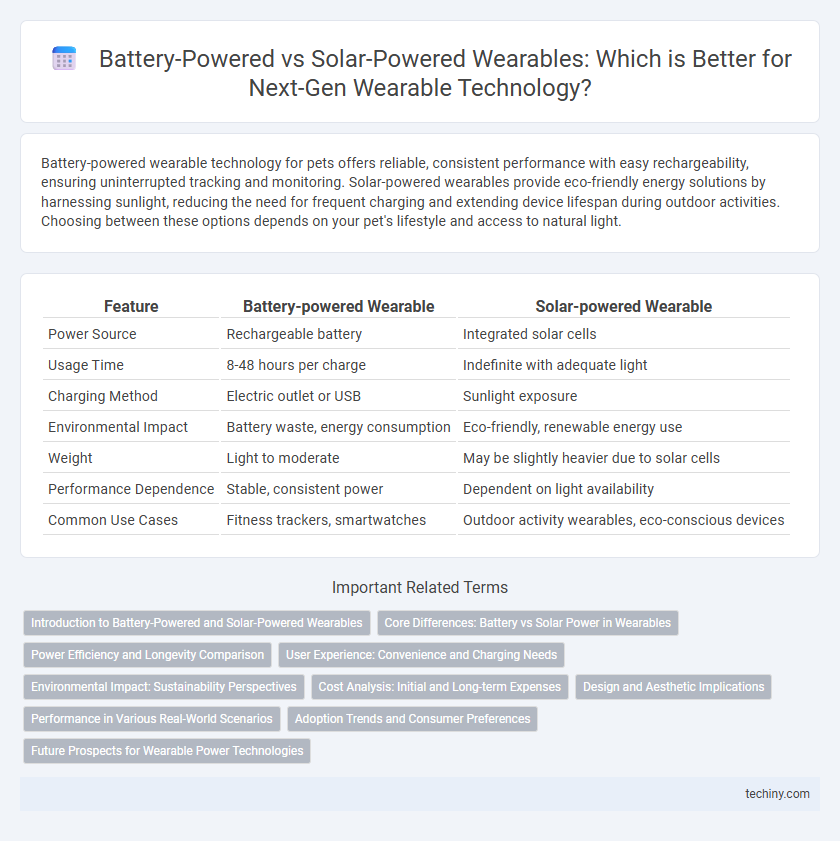Battery-powered wearable technology for pets offers reliable, consistent performance with easy rechargeability, ensuring uninterrupted tracking and monitoring. Solar-powered wearables provide eco-friendly energy solutions by harnessing sunlight, reducing the need for frequent charging and extending device lifespan during outdoor activities. Choosing between these options depends on your pet's lifestyle and access to natural light.
Table of Comparison
| Feature | Battery-powered Wearable | Solar-powered Wearable |
|---|---|---|
| Power Source | Rechargeable battery | Integrated solar cells |
| Usage Time | 8-48 hours per charge | Indefinite with adequate light |
| Charging Method | Electric outlet or USB | Sunlight exposure |
| Environmental Impact | Battery waste, energy consumption | Eco-friendly, renewable energy use |
| Weight | Light to moderate | May be slightly heavier due to solar cells |
| Performance Dependence | Stable, consistent power | Dependent on light availability |
| Common Use Cases | Fitness trackers, smartwatches | Outdoor activity wearables, eco-conscious devices |
Introduction to Battery-Powered and Solar-Powered Wearables
Battery-powered wearables rely on rechargeable lithium-ion or lithium-polymer batteries, offering consistent energy output and compact design suitable for continuous use in smartwatches, fitness trackers, and medical devices. Solar-powered wearables integrate photovoltaic cells to harness ambient light, providing extended operation times and enhanced sustainability by reducing the need for frequent charging. Advances in energy storage and solar panel efficiency are driving innovation in both technologies, improving user convenience and device longevity.
Core Differences: Battery vs Solar Power in Wearables
Battery-powered wearables rely on rechargeable lithium-ion or lithium-polymer cells, offering consistent energy output and longer operational duration between charges but requiring regular recharging cycles. Solar-powered wearables utilize photovoltaic cells to convert sunlight into energy, extending device runtime in outdoor settings and reducing dependence on electrical outlets but often facing limitations in low-light conditions. Core differences hinge on energy availability, charging convenience, and environmental sustainability, influencing user experience and device design.
Power Efficiency and Longevity Comparison
Battery-powered wearables typically offer higher power efficiency and longer continuous usage due to stable energy output, often lasting 1-3 days on a single charge depending on device functions. Solar-powered wearables enhance longevity by harvesting ambient light, enabling extended use in outdoor conditions but usually with slower recharge rates and reliance on exposure to sunlight. Combining battery storage with solar charging technology balances power efficiency and device lifespan, making wearables more sustainable for long-term use.
User Experience: Convenience and Charging Needs
Battery-powered wearables offer consistent performance with straightforward recharging via USB or charging docks, ensuring minimal disruption during daily use. Solar-powered wearables extend device autonomy by converting ambient light into energy, reducing dependency on electrical outlets and enhancing convenience for users on the go. However, solar charging efficiency varies with environmental conditions, potentially impacting uninterrupted functionality compared to traditional battery-powered devices.
Environmental Impact: Sustainability Perspectives
Battery-powered wearables rely heavily on lithium-ion batteries, which involve resource-intensive mining processes and pose disposal challenges contributing to environmental pollution. Solar-powered wearables harness renewable energy, reducing dependence on finite resources and minimizing carbon footprints through prolonged use without frequent battery replacements. Emphasizing sustainable materials and energy-efficient designs in wearable technology promotes eco-friendly innovation and aligns with global environmental goals.
Cost Analysis: Initial and Long-term Expenses
Battery-powered wearables generally incur lower initial costs due to established manufacturing processes and affordable lithium-ion batteries, while solar-powered wearables require higher upfront investment because of integrated photovoltaic cells and advanced energy management systems. Over the long term, solar-powered devices offer significant savings by reducing or eliminating the need for frequent battery replacements and external charging, enhancing sustainability and lowering maintenance expenses. Cost analysis favors battery-powered options for short-term affordability, whereas solar-powered wearables provide economic benefits through durable, self-sustaining energy sources in prolonged usage scenarios.
Design and Aesthetic Implications
Battery-powered wearables prioritize compact design and lightweight materials to accommodate internal cells, often resulting in a sleek but limited form factor. Solar-powered wearables integrate photovoltaic elements, influencing aesthetics with exposed panels or textured surfaces that blend technology with fashion. The choice between these power sources drives innovation in wearable design, balancing functionality with visual appeal.
Performance in Various Real-World Scenarios
Battery-powered wearables offer consistent performance across diverse environments, providing reliable energy output during extended use and in low-light conditions. Solar-powered wearables excel in outdoor scenarios with abundant sunlight, enhancing battery life and sustainability but may struggle with efficiency indoors or on cloudy days. Balancing energy source with user lifestyle is critical for optimizing wearable performance in real-world applications.
Adoption Trends and Consumer Preferences
Battery-powered wearables dominate the market due to their reliable energy supply and widespread availability, with adoption driven by advancements in battery life and fast charging technologies. Solar-powered wearables are gaining traction among eco-conscious consumers seeking sustainable options, although their limited sunlight dependence restricts broader usage. Market analysis indicates a growing niche for hybrid models combining battery power with solar charging to enhance user convenience and device autonomy.
Future Prospects for Wearable Power Technologies
Battery-powered wearables currently dominate the market due to their high energy density and reliable power output, enabling longer usage times and advanced functionalities. Solar-powered wearables offer promising future prospects by harnessing renewable energy, reducing the need for frequent charging, and improving sustainability in smartwatches, fitness trackers, and health monitoring devices. Emerging hybrid power systems that combine battery storage with solar energy capture are expected to enhance efficiency and extend operational life, driving innovation in wearable power technologies.
Battery-powered Wearable vs Solar-powered Wearable Infographic

 techiny.com
techiny.com